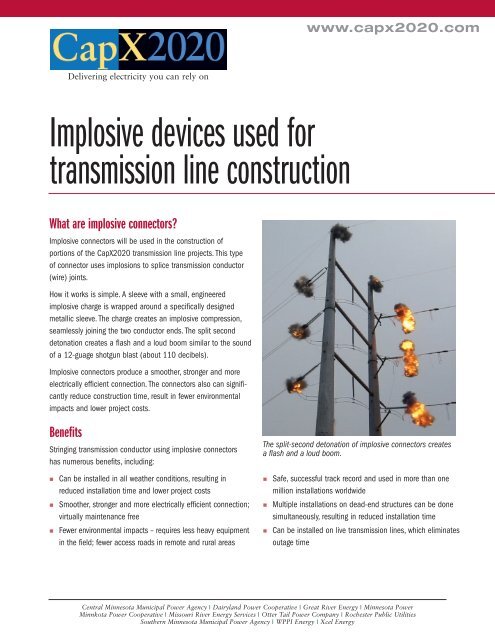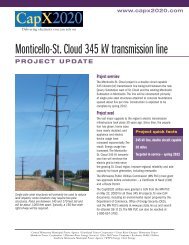Implosive devices used for transmission line construction - CapX2020
Implosive devices used for transmission line construction - CapX2020
Implosive devices used for transmission line construction - CapX2020
Create successful ePaper yourself
Turn your PDF publications into a flip-book with our unique Google optimized e-Paper software.
www.capx2020.com<br />
Delivering electricity you can rely on<br />
<strong>Implosive</strong> <strong>devices</strong> <strong>used</strong> <strong>for</strong><br />
<strong>transmission</strong> <strong>line</strong> <strong>construction</strong><br />
What are implosive connectors?<br />
<strong>Implosive</strong> connectors will be <strong>used</strong> in the <strong>construction</strong> of<br />
portions of the <strong>CapX2020</strong> <strong>transmission</strong> <strong>line</strong> projects. This type<br />
of connector uses implosions to splice <strong>transmission</strong> conductor<br />
(wire) joints.<br />
How it works is simple. A sleeve with a small, engineered<br />
implosive charge is wrapped around a specifically designed<br />
metallic sleeve. The charge creates an implosive compression,<br />
seamlessly joining the two conductor ends. The split second<br />
detonation creates a flash and a loud boom similar to the sound<br />
of a 12-guage shotgun blast (about 110 decibels).<br />
<strong>Implosive</strong> connectors produce a smoother, stronger and more<br />
electrically efficient connection. The connectors also can significantly<br />
reduce <strong>construction</strong> time, result in fewer environmental<br />
impacts and lower project costs.<br />
Benefits<br />
Stringing <strong>transmission</strong> conductor using implosive connectors<br />
has numerous benefits, including:<br />
The split-second detonation of implosive connectors creates<br />
a flash and a loud boom.<br />
n<br />
n<br />
n<br />
Can be installed in all weather conditions, resulting in<br />
reduced installation time and lower project costs<br />
Smoother, stronger and more electrically efficient connection;<br />
virtually maintenance free<br />
Fewer environmental impacts – requires less heavy equipment<br />
in the field; fewer access roads in remote and rural areas<br />
n<br />
n<br />
n<br />
Safe, successful track record and <strong>used</strong> in more than one<br />
million installations worldwide<br />
Multiple installations on dead-end structures can be done<br />
simultaneously, resulting in reduced installation time<br />
Can be installed on live <strong>transmission</strong> <strong>line</strong>s, which eliminates<br />
outage time<br />
Central Minnesota Municipal Power Agency | Dairyland Power Cooperative | Great River Energy | Minnesota Power<br />
Minnkota Power Cooperative | Missouri River Energy Services | Otter Tail Power Company | Rochester Public Utilities<br />
Southern Minnesota Municipal Power Agency | WPPI Energy | Xcel Energy
old splicing technology (left), implosive<br />
splicing technology (right)<br />
Workers prepare an implosive connector <strong>for</strong> detonation.<br />
Terms to know<br />
Conductor: A wire made up of multiple aluminum strands around a steel core that together carry electricity.<br />
Insulator: An object made of a material like glass, porcelain or composite polymer that is a poor conductor of<br />
electricity. Insulators are <strong>used</strong> to attach conductors to the <strong>transmission</strong> structure and to prevent a short circuit from<br />
happening between the conductor and the structure.<br />
Dead end structure: A structure <strong>used</strong> when a <strong>transmission</strong> <strong>line</strong> turns or ends. It’s usually stronger and larger with a<br />
wider base.<br />
<strong>Implosive</strong> joining: A sleeve with a small, engineered implosive charge wrapped around a metallic sleeve that creates<br />
a controlled implosive compression that seamlessly joins high voltage conductor.<br />
Sleeve: There are two sleeves <strong>used</strong> during an implosion connection, a sleeve made out of metal and another that<br />
contains an engineered implosive charge.<br />
Contact us<br />
Tim Carlsgaard<br />
<strong>CapX2020</strong> communications manager<br />
(612) 330-7697<br />
timothy.s.carslgaard@xcelenergy.com<br />
Randy Fordice<br />
<strong>CapX2020</strong> communications representative<br />
(763) 445-5713<br />
r<strong>for</strong>dice@grenergy.com<br />
CONDUCTOR<br />
METALLIC SLEEVE<br />
IMPLOSIVE ENERGY<br />
4-23-2013











